When Jule Schaffer asked me to write a review of Christo and Jean-Claude’s The Floating Piers, Lake Iseo, Italy 2014-2016 I was quite reluctant… I had just come back to Cologne after having been a member of The Floating Piers team for two emotionally, physically intense weeks. I was not mentally prepared to digest this experience yet. Actually, my unconscious had suggested for me to leave the copy of the above-mentioned Taschen book that Christo had signed and given to all the members of the team, on the shelf of my Milan pied-à-terre. I also left the folder containing the numerous press clippings on the project I had collected during the past weeks. Contrary to what I usually do, I had already downloaded the hundreds of pictures taken in those days, putting them in a sub-sub-sub-folder of my laptop, hoping not to spend the rest of the summer staring at them. I was persuaded that all these moves should have enabled me to fully concentrate on my future commitments. Already after the first night in Cologne I realized how wrong I was… for the following nights I kept dreaming that the project was still on, I was still living on the beautiful coast of Lake Iseo, coordinating via radio from the head quarters with the colleagues who were working on the piers, and, of course, experiencing every night the sense of magnitude, urgency and excitement (and sometimes the fight against adverse weather conditions) which had been a constant of The Floating Piers. Luckily, Jule asked me again if I wanted to write a blog post about the book and, alongside, on the project. I accepted her invitation, hoping that the text will have a therapeutic effect.
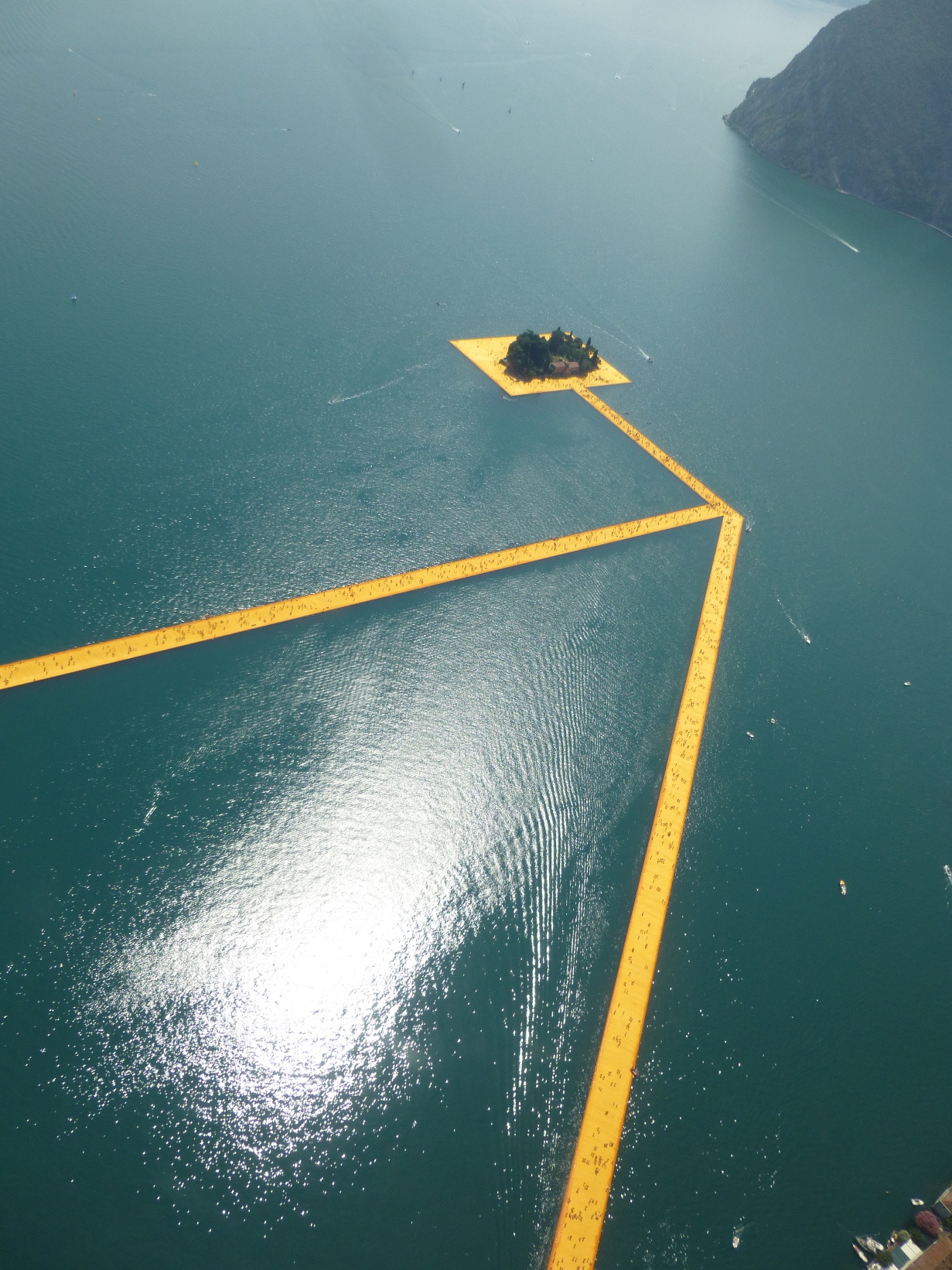
(c) Francesca Valentini
Christo and Jeanne-Claude’s The Floating Piers, Lake Iseo, Italy, 2014-2016 is the 120 page book-diary published by Taschen to accompany, document, and keep alive, the homonymous project by Christo (b. 1935) and Jean-Claude (1935-2009).
The two artists initially envisaged the project in 1970 when a floating pier was to be built on the Argentinian Rio del Plata. In 1996 they tried to make it happen in the Bay of Tokyo, something which, for various reasons, was again not possible. Finally, Christo was able to realize an even more complex project on the Lake Iseo, Italy.
After having gained the favor of the local authorities, the artist, with the help of an international team of technicians and experts, created a system of floating piers to connect the small village of Sulzano (on the eastern shore of the lake) to Montisola (the largest lake island in Europe) and Montisola to San Paolo, a small neighboring island. The piers, measuring 3km were covered with a shimmering dahlia yellow fabric, which extended onto the streets and the squares of the villages of Sulzano and Peschiera Maraglio as well as the path that connects the villages of Peschiera Maraglio and Sensole (on Montisola) for a total of 4,5km of walking path.
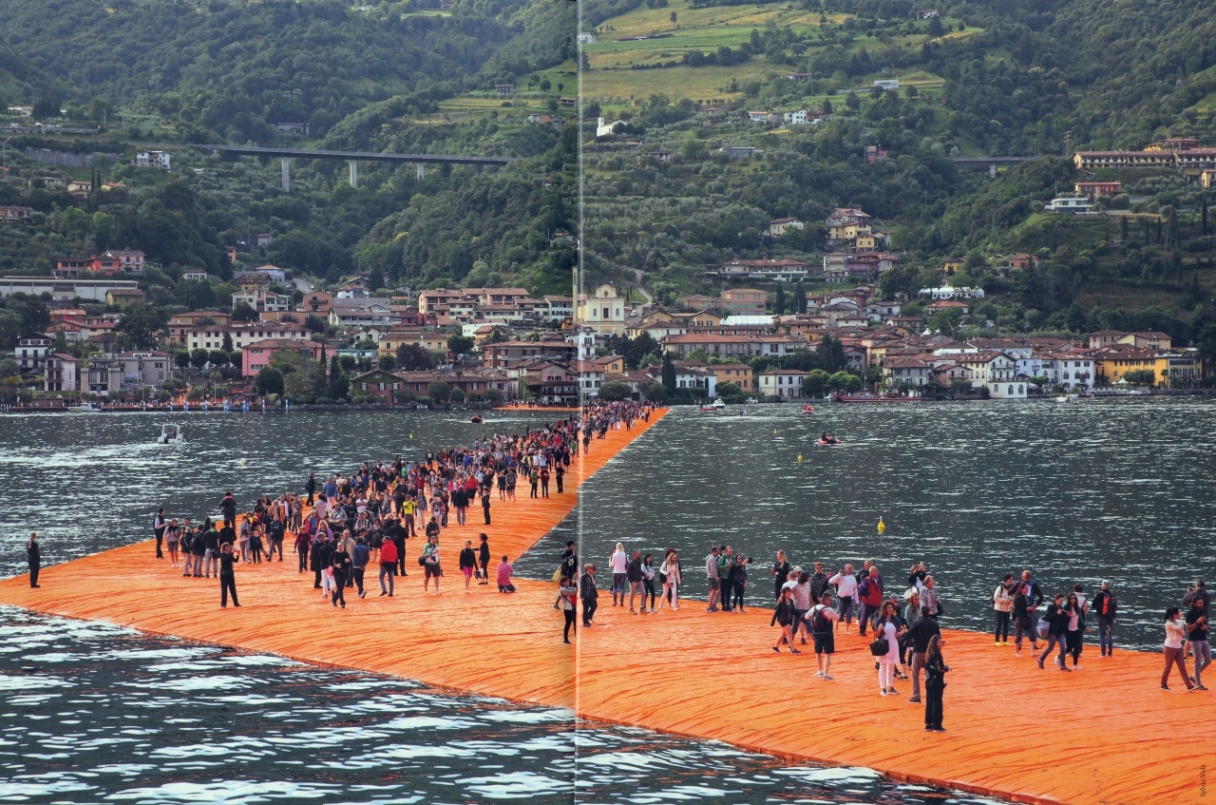
Christo & Jeanne-Claude – The Floating Piers – 2014-2016, pp. 110-111
Welcomed and supported by hundreds of monitors, more than 1.200.000 people experienced the installation during the two weeks of its opening. The monitors, an international community of employees trained on sight for the occasion, constituted the most numerous part of The Floating Piers’ team. The international team also included, among others, engineers, scuba divers, construction workers, and art historians.
The book The Floating Piers documents and explains through images and short texts the entire and complex process that contributed to the creation of the artwork. It includes photographical reproductions of the numerous works created by Christo to visualize the final aspect and the visual impact of The Floating Piers, as well as images shot once the installation was completed, some of them showing how the multitude of visitors interacted with the oeuvre.
As most of the publications by Taschen, the book has the merit to be very accessible not only in economic terms but also in terms of content. Apart from a few shots that were not particularly successful (pp. 116-117), the images illustrate all the steps of the project really well: from the initial stages, to those of persuasion of the different stakeholders involved and negotiation with the local authorities (pp. 18-19), to those of study and testing the feasibility (pp. 28-29), to those of the productions of the different materials (pp. 42-43).
All phases of the project required a great technical competency but also a visionary spirit. All this accompanied by the possibility to deploy resources and manpower. See, as an example, the development of the system of anchors and ropes that held the fixed piers to the lake bottom, the transportation and laying of the felt lining of the piers and the walkable paths (pp. 98-99), the laying of the fabric and its stitching in situ, using portable sewing machines which took place mainly during the nights between the 15th and 17th June (pp. 104-105).
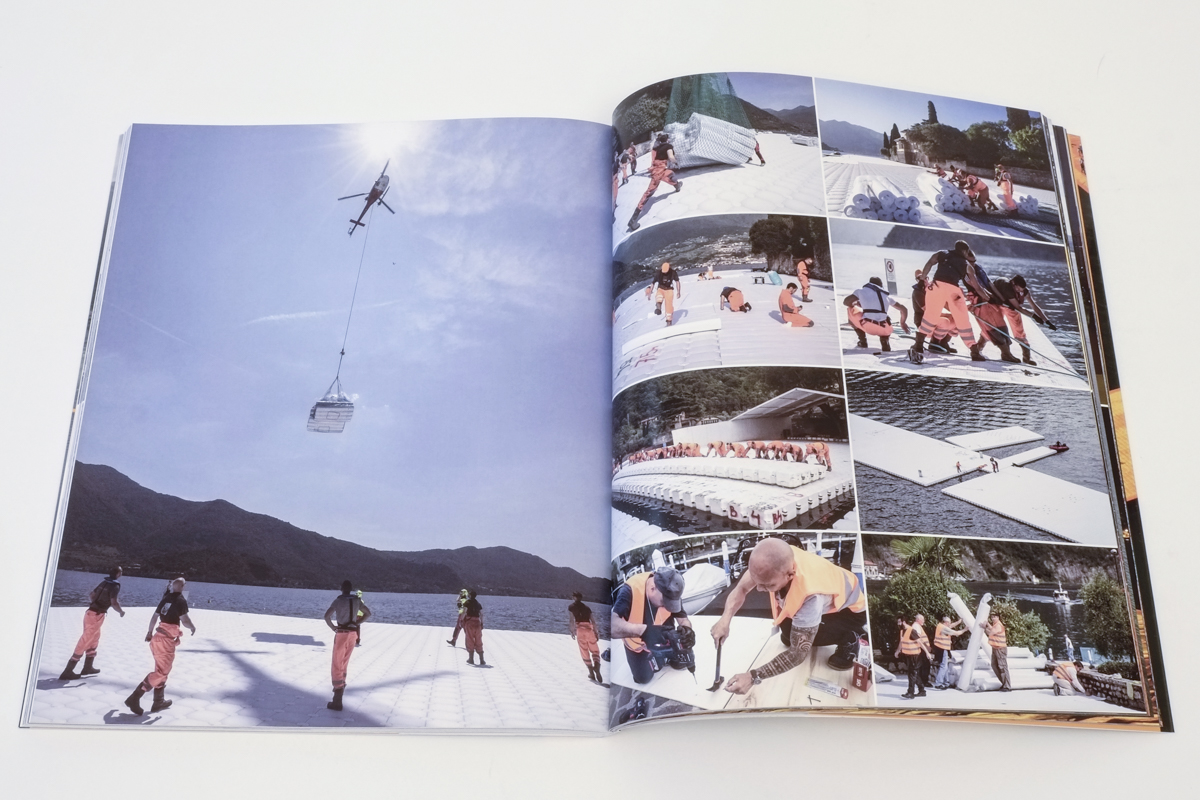
Christo & Jeanne-Claude – The Floating Piers – 2014-2016, pp. 98-99
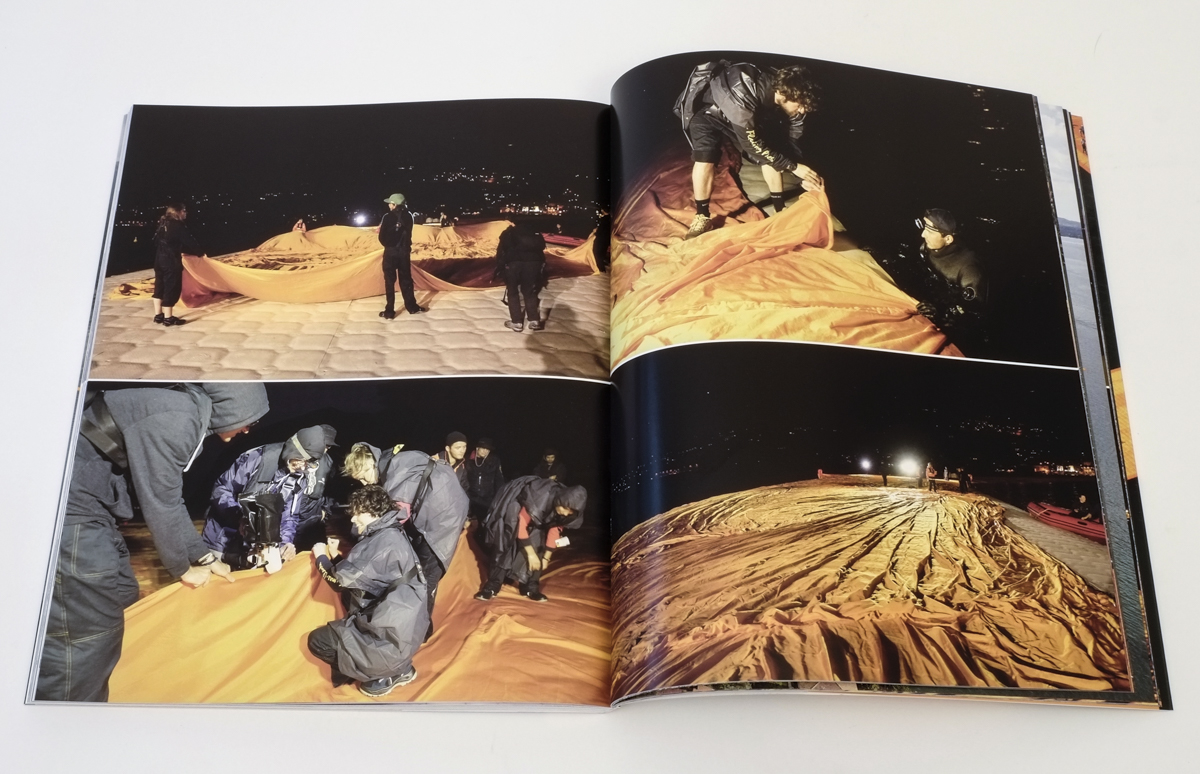
Christo & Jeanne-Claude – The Floating Piers – 2014-2016, pp. 104-105
Some aerial views in the double pages beautifully immortalize some of the most grandiose aspects of the enterprise, i.e. the storage of the 16x100m modules which, once mounted together, composed the piers (pp. 90-91), the fabric once completed its successful installation (pp. 114-115), and, of course, the first visitors (pp. 118-119). Almost all the photographs are by Wolfgang Volz, the trustworthy photographer who has the exclusive on the work of the artists. Since 1972 he had in fact tirelessly documented and interpreted their oeuvre. The book also contains reproductions of many studies and finished works created by Christo as part of the project. Note, that he works without assistants and that he completely self-financed The Floating Piers through the sale of his works in other mediums. Unfortunately, these works are not well represented through photography, given that, besides its visual composition, it is especially the combination of different techniques and materiality (drawing, painting, photographs, maps, and sometimes even fabric) that makes them so interesting and appealing. However, the presence of these works within the book allows the reader to better contextualize the abundant photographic documentation, to better understand how “the master” intervened on the environmental setting offered by the beautiful Lake Iseo, thus immediately grasping his visionary and dedicated spirit. The eighty-one year old artist has worked tirelessly to realize this project, actively participating in all phases of its development (if you do not believe me, believe the pictures in the book! See, for example, p. 102).
Within the book, short commentaries by Jonathan Henery, the artist’s nephew who was closely involved in the project and Wolfgang Volz accompany the information conveyed by images, providing some additional details.
Although the thin volume is a beautiful diary of this colossal project, the fact that it was produced quickly in order to be on sale shortly after the opening of The Floating Piers reflects upon the poor quality of some images, the lack of various captions, and the poverty of the Italian translations.
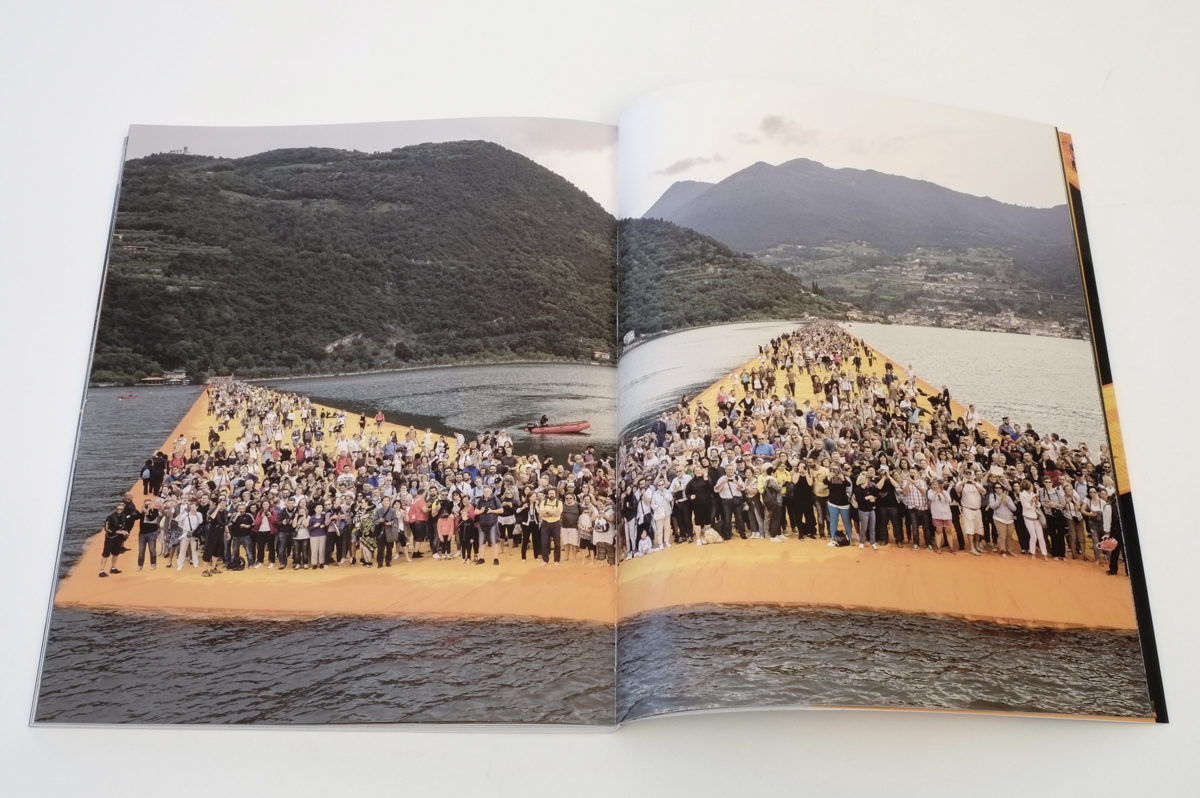
Idolatry moments – visitors taking pictures of the barge from which the artist, during one of his numerous daily tours, greets them. Christo & Jeanne-Claude – The Floating Piers – 2014-2016, pp. 120-121
I would like to end this review with some observations on the relationship between The Floating Piers and its visitors.
Although it was estimated that the event would attract about 500,000 visitors during its 16 days of opening (a very large number if compared, for example, to the attendance of the 2015 Venice Biennale which was only 525,500 visitors within more than six months of opening!) an exceptional number of more than 1,200,000 people walked on The Floating Piers.
Leaving aside some remarks on the environmental sustainability of this stream of visitors coming from every continent to experience the work of Christo, literally invading places which are topographically not prepared to welcome this incredible flow of tourists, I would like to stress here the incredible diversity of the project’s audience.
The diversity of the audience has in fact impressed me very much.
Newbies and real Christologists mingled with those who had never heard of the artist, but were persuaded (largely by local and national media) of the uniqueness of the event. „Seit dem Wrapped Reichstag (1971-1995) bin ich ein Christologe” said Max, a German man in his forties whom I met during a site visit, and who gave me a portion of the fabric with which Christo and Jeanne-Claude wrapped the German parliament in 1995.
Some have been persuaded by friends and relatives to travel to Sulzano, then queuing for up to 5 hours to access the piers… if you think this is too much, let me tell you about my brother in law and his family whom I apologize to for having convinced them to put themselves on the road… due to overcrowding, the bus on which they were sitting stopped well before Sulzano… so they never reached The Floating Piers.
Numerous globe trotters of the art world should be added to this diverse audience of pilgrims, consisting mostly of people who rarely set foot in a museum. One could mention, among many others, Carolyn Christov-Bakargiev who shares her Bulgarian origins with Christo, or Klaus Biesenbach who willingly helped some teenagers in their struggle with a dramatic selfie: how to fit it all in the frame, the smiling and the piers as a background?
Moreover, members of the political world (from deputies to princesses…) and many national and international celebrities (i.e. Luciana Littizzetto and Brad Pitt) should be added – excuse me for the combination but I could not miss the opportunity to make a nice gift to my fellow citizen mentioning her in company of the legendary Brad ;-).
In short: contemporary art professionals and enthusiasts apart, what made all these people visit The Floating Piers?
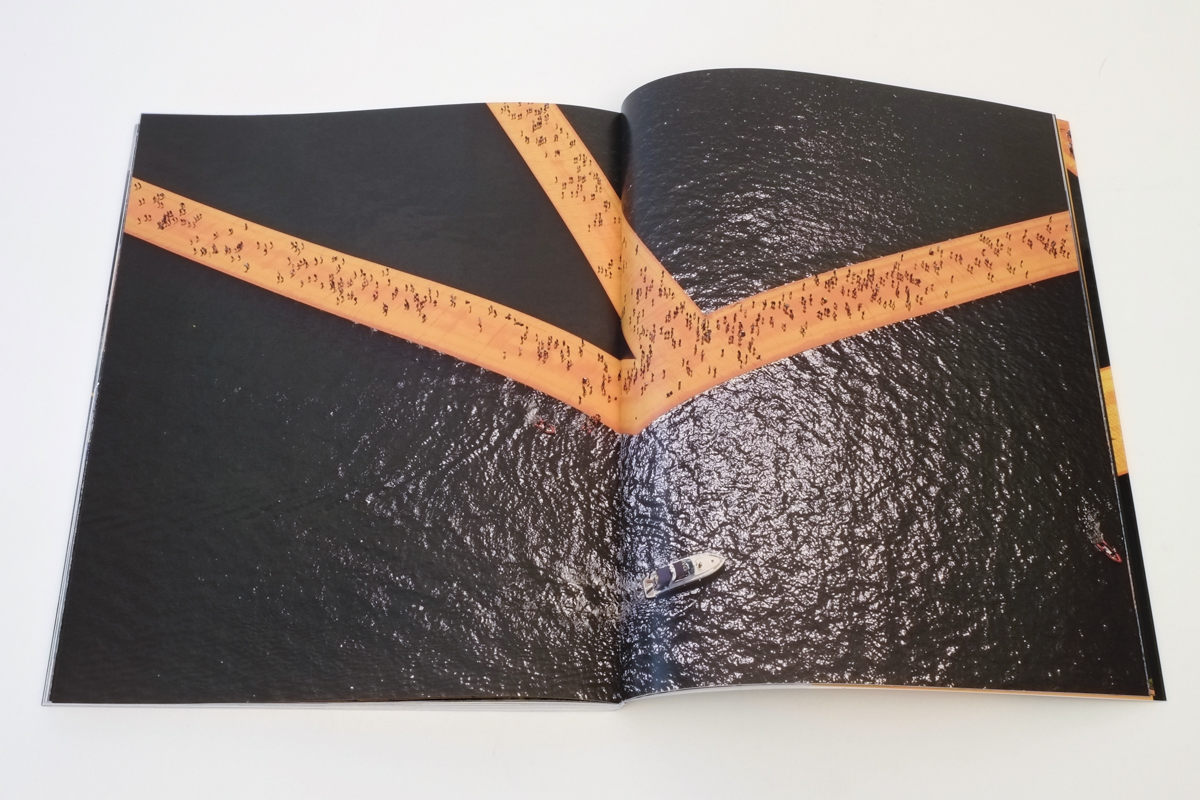
Christo & Jeanne-Claude – The Floating Piers – 2014-2016, pp. 118-119
Leaving apart the Biblical appeal (indeed there is something very biblical in the name of the artist and the miracle of walking on water…) why day after day have hundreds and hundreds of visitors invested time and money to experience the swaying of the piers, the passage to the mainland covered with olive trees, the sparkle of the work’s shimmering coverage under the light reflected by the lake and framed by beautiful mountains? Why, despite the hour-long queue and the deadly heat announced on the project’s website, were the visitors not intimidated?
Mainly for the so-called uniqueness of the event. A unique event, lasting only 16 days.
Admiring The Floating Piers at sunset from the top of a nearby mountain shortly before leaving for Milan directed to Cologne I thought that the work, paradoxically, shows how much we can willingly sacrifice in order to give value to unique events. After all, if we think about it carefully, there are tons of unique things that happen in our lives. If we want to keep the focus purely on the art and its world we must recognize that even the exhibitions at the local museums are unique, but all too often we miss them. Is it a survival strategy? In part, I think so. Then there are art books and exhibition catalogues that tell us how things went. I consider that it is all well and good to give a copy of Christo and Jeanne-Claude’s The Floating Piers, Lake Iseo, Italy, 2014-2016 to my brother-in-law… I am sure that, despite everything, he will appreciate this gift.
At this point, I cannot figure out whether writing this short review has been therapeutic or not. If yes, this night I will discover its positive effect when I will start dreaming something else. If not, I could turn to the Facebook group of The Floating Piers’ insiders, the virtual place where the melancholy that most of the members of the team have taken home leaving the shores of the Lake Iseo is tragicomically reprocessed. Or, last choice, I could join the ranks of the team members who have tattooed on their skin the stylized map of The Floating Piers…
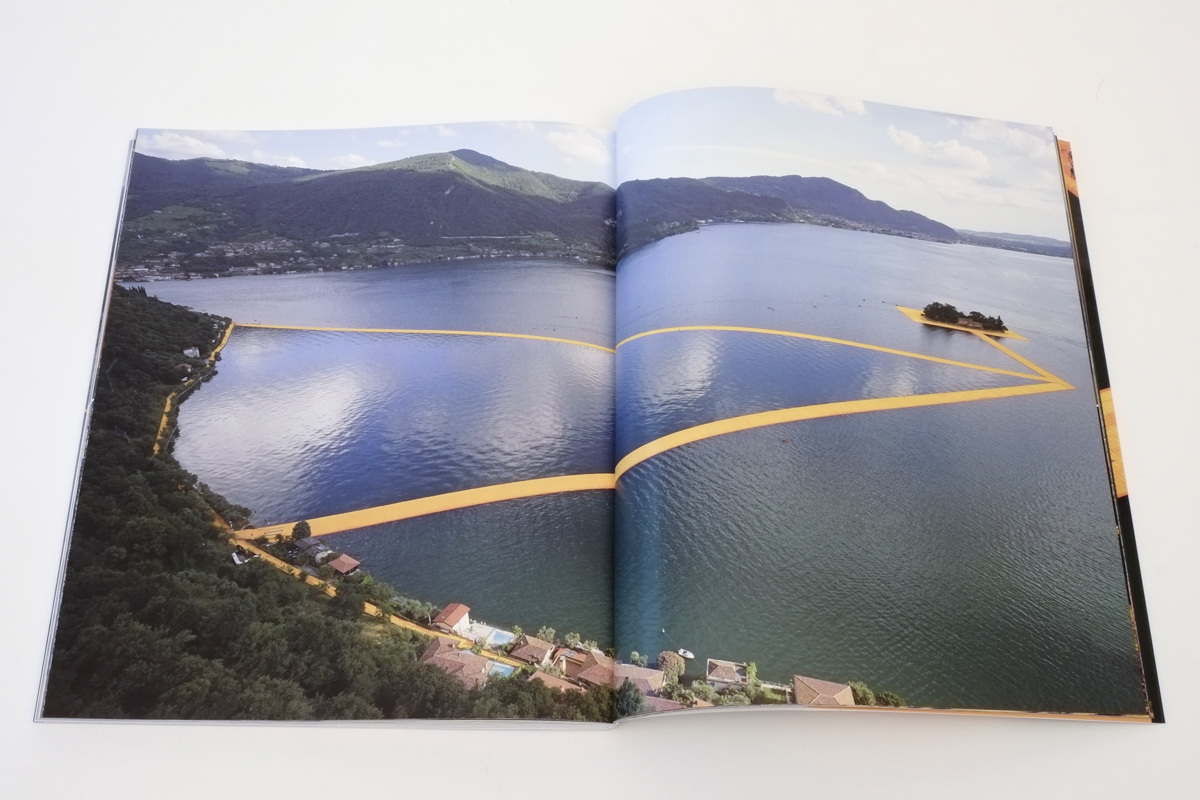
idolatry moments – visitors taking pictures of the barge from which the artist, during one of his numerous daily tours, greets them. Christo & Jeanne-Claude – The Floating Piers – 2014-2016, pp. 114-115
A postscriptum to conclude this psychoanalytical experiment 2.0.
One of the most controversial elements of The Floating Piers was the fact that the island of San Paolo belongs to the Berettas – leading manufacturers of weapons globally. Within the Taschen book this issue is never thematized and the Beretta, the family that willingly allowed Christo to embed their island in his project, are just described as the owners of “one of the oldest family-businesses in Europe, operating since 1526.” (p. 14)
Although the topic is ethically very controversial, I believe that keeping a low profile in the book (but not only) was a good choice. Despite the ridiculous public statement in which the entrepreneurs tried to instrumentalize the project — on June 18, 2016 the Beretta posted on their Facebook page: “a small island, belonging to the Beretta family, plays a leading role in an art installation. Next time someone tells you guns don’t make art…” —, the Beretta family and their business deserve no advertisement whatsoever.
Christo & Jeanne-Claude – The Floating Piers – 2014-2016, Lake Iseo, Italy, 2014-2016. Photographs by Wolfgang Volz. 2016. 29 x 23.5 cm. 128 p. Paperback with flaps. Text in English and Italian language. TASCHEN
You can get a copy of „The Floating Piers“ @artbooksonline.eu

